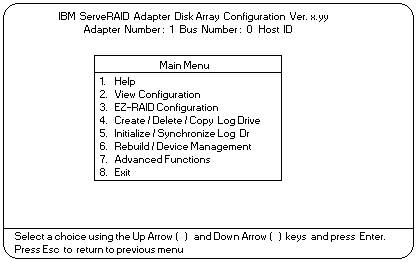ServeRAID Menus, Screens, and Drive States
ServeRAID Menus, Screens, and Drive States
The following information describes the Main
Menu, the ServeRAID screens and pop-up windows, the
physical device states, and the logical drive states.
Main Menu: The following illustration shows the Main
Menu of the IBM ServeRAID Configuration program.

Descriptions of the choices available from the Main Menu are as follows:
- Help provides information about the choices available
on the menu. You also can press F1 from any screen to
obtain online Help.
- View Configuration displays the existing disk-array
configuration information. See 'Viewing or Changing the Configuration' for more information.
- EZ-RAID Configuration automatically creates a
configuration based on the number of physical drives installed in the system.
See 'Using the EZ-RAID Configuration Feature' for more information.
- Create/Delete/Copy Log Drive lets you manually create
the disk arrays. You can select the drives that you want
to include in an array. (See 'Creating Disk Arrays Manually' for more information.)
You also can select this choice to define, delete, or copy logical drives and to define hot-spare drives.
- Initialize/Synchronize Log Dr prepares the drives for data storage. RAID level 5 logical drives are automatically
synchronized when you initialize them. See
'Initializing/Synchronizing Logical Drives at the Same Time' for more information.
- Rebuild/Device Management rebuilds RAID level 1 and RAID level 5 logical drives. You also can select this choice
to define or change the state of a physical drive, view drive information, and clear the Device Event Log. (See
'Maintaining the Disk-Array Configuration' for
more information.)
- Advanced Functions lets you change the write policy (the way data is written to the drive), save the
configuration information to a diskette, restore the configuration from a diskette, or change the ServeRAID
controller parameters. You also can select this choice to run the RAID subsystems diagnostics, initialize the
controller configuration, reset the configuration values to the factory defaults, and select a source (hard disk,
NVRAM, Flash) from which to synchronize the ServeRAID controller configuration.
- Exit lets you exit from the Main Menu of the ServeRAID
Configuration program.
Screens and Pop-Up Windows: The following
illustration is a compilation of several configuration screens
that appear when you use the IBM ServeRAID
Configuration program.

Descriptions of the labeled areas in this illustration are as follows:
- Pop-up windows that apply to the current menu appear in this area of the screen. For example,
when you need to confirm an action, the Confirm pop-up window appears in this area.
- You can select any of the choices that appear on the menu. To make a selection from a menu, type
the highlighted number of the menu item, or use the Up Arrow (
 ) or Down Arrow (
) or Down Arrow (  ) key to highlight
the choice, then, press Enter. You can press the Esc key to return to a previous menu, to a previous
work area of a screen, or to the Main Menu.
) key to highlight
the choice, then, press Enter. You can press the Esc key to return to a previous menu, to a previous
work area of a screen, or to the Main Menu.
- The Array/Bay selection list shows the bays for the ServeRAID controller. For each bay that contains a
drive, the list indicates the array in which the drive is grouped and the physical device state. (See
'Physical Device States' for more information.) For example, in the illustration, the
drive in Channel 1, Bay 1 has a drive state of online (ONL) and is part of Array A.
Note:
- The Array/Bay selection list does not reflect the physical configuration of the server.
(See 'Internal Drive Bays' for the physical location of the hard disk drives.)
- The SCSI IDs for the hot-swap hard disk
drives is set by the backplane. The backplane allows you to define the IDs as
low (0 to 5) or high (8 to 13). See 'SCSI Backplane Option Jumpers'
for more information about setting jumpers on the backplane.
- The bay number corresponds to the SCSI ID of the device plus 1. For example, the
ServeRAID controller (INI) uses SCSI ID 7 and its bay number is 8 (7 + 1).
- Bay Number 8 (SCSI ID 7) is reserved for the ServeRAID controller (also known as
the initiator, INI), therefore do not set the SCSI ID of non-hot-swap device, such as a tape drive, to 7.
- The Array list indicates the array IDs and the sizes (in megabytes) of the arrays.
When a drive is being rebuilt, this list and the Logical Drive list show the
progression of the rebuild process.
- The Logical Drive list shows the size, RAID level,
status, and write policy for each logical drive. (See
'Logical Drive States' for more information.)
- This area provides information and instructions
about the actions you can perform on the current screen or pop-up window.
Back to 
Please see the LEGAL - Trademark notice.
Feel free - send a  for any BUG on this page found - Thank you.
for any BUG on this page found - Thank you.



 ) or Down Arrow (
) or Down Arrow (  ) key to highlight
the choice, then, press Enter. You can press the Esc key to return to a previous menu, to a previous
work area of a screen, or to the Main Menu.
) key to highlight
the choice, then, press Enter. You can press the Esc key to return to a previous menu, to a previous
work area of a screen, or to the Main Menu.
 for any BUG on this page found - Thank you.
for any BUG on this page found - Thank you.